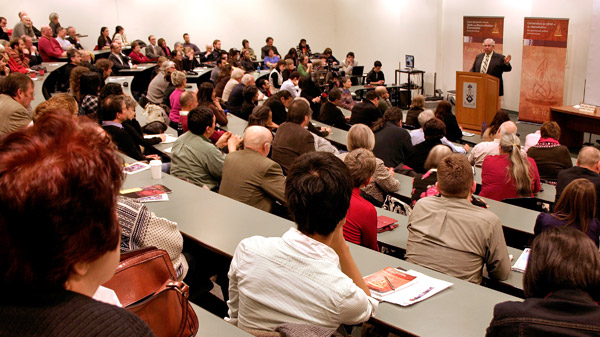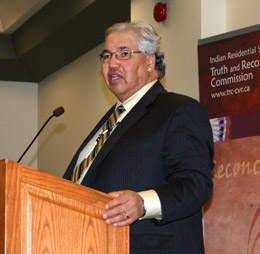By Lucianna Ciccocioppo
Getting to the truth of the native residential schools experience comes with many challenges, says Justice Murray Sinclair, chair of the Truth and Reconciliation Commission, with the biggest one weighing most heavily on his mind.
"What can we do to make it right?"
Sinclair lectured Dec. 11 to an audience of more than 250 at the Faculty of Law as part of a symposium of scholars gathered to create a research centre on the residential schools experience and examine the role of the University of Toronto during those years. Some of the teachers at the time came from the religious colleges affiliated with U of T.
A dark part of Canada's legacy, the residential schools program took Aboriginal children between seven and 15 years of age away from their families to boarding schools run by religious institutions to "civilize them, indoctrinate them, and to take away their 'Indian-ness,'" says Sinclair.
Back in early 19th century Canada - the 18th century in Quebec - the residential programs were part of a school clause where treaty signers promised to educate Aboriginal children.
"What they did was turn the schools into industrial feeder institutions - slave labour - for the benefit of local businesses and farming communities," says Sinclair. And as outraged Aboriginal parents tried to take back their children, their rights were stripped by the Canadian government, the Crown indignant that communities dared remove their children from the schools.
People in the audience shook their heads in disbelief as Sinclair described the Canadian legal architecture that created and perpetuated the schools.
"Indigenous peoples have been thwarted in their attempts to contest the damaging aspects of the schools by laws preventing them from voting, protesting, hiring legal counsel and otherwise acting to protect their children from harm," says Kim Stanton, a PhD candidate at Faculty of Law who helped organize the event.
Even lawyers were banned from advocating on their behalf - at the risk of disbarment.
"The program's aim was to separate Aboriginal children from their families and treat them differently - so they could be similar to non-aboriginal children," says Sinclair. But non-aboriginal children did not have their lives ripped apart by years of isolation from their families, while enduring physical, mental and sexual abuse by teachers and priests - and, says Sinclair, other students.
"This is one of the most challenging areas for the TRC, student-on-student abuse," says Sinclair. "Many survivors and abusers are still alive and of the same age.
"The abuser can now be an elected leader in the community," says Sinclair, "or is a family member. Therefore it's the abuse that lingers the longest." Sinclair argues that this form of ongoing contact between survivors and abusers contributes to the pervasive problems in today's Aboriginal communities. He hopes that the TRC will "bring balance back to people's lives" and empower them to deal with the wrongs of the past.
Sinclair says the TRC wants to create a national research centre housing documents and story collections open to the public "so this part of the country's legacy would never be allowed to occur again." But the large number of people affected by the residential schools experience - approximately 90 thousand - creates other challenges.
"We want everyone to have the opportunity to tell their story, but how do we do it effectively for future researchers?" says Sinclair. And how do we preserve this important piece of history for future generations, including the children and grandchildren of survivors?
The five-year mandate of the TRC "is not long enough," says Sinclair. "It took 150 years to reach this point in time. It will take many generations to restore relationships and balance.
"Maybe we can begin to show the way."
View the photo gallery of Justice Murray Sinclair's lecture.

Photos by: Diana Balogh-Tyszko


